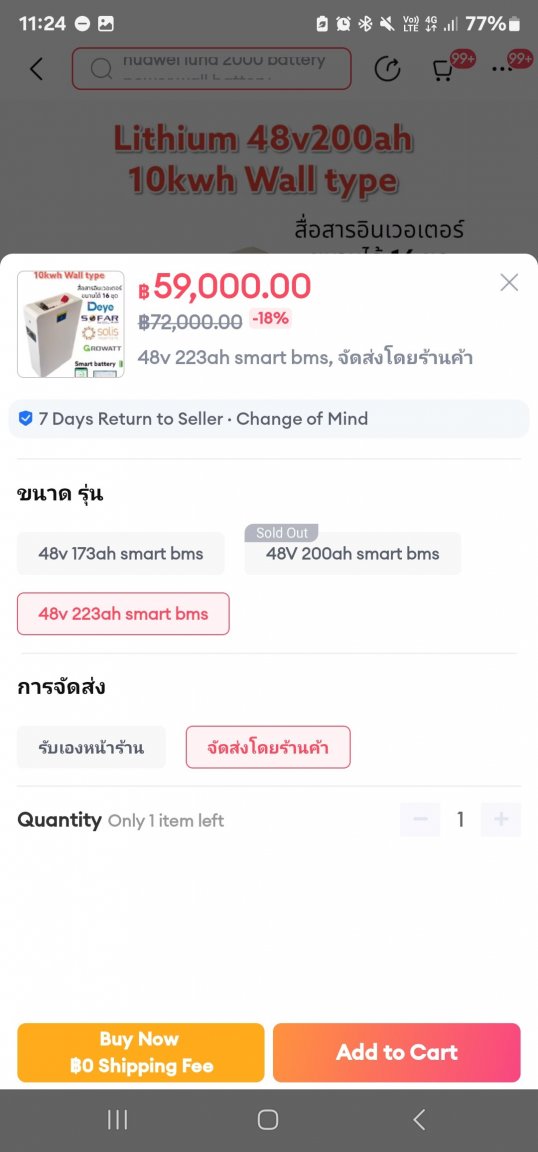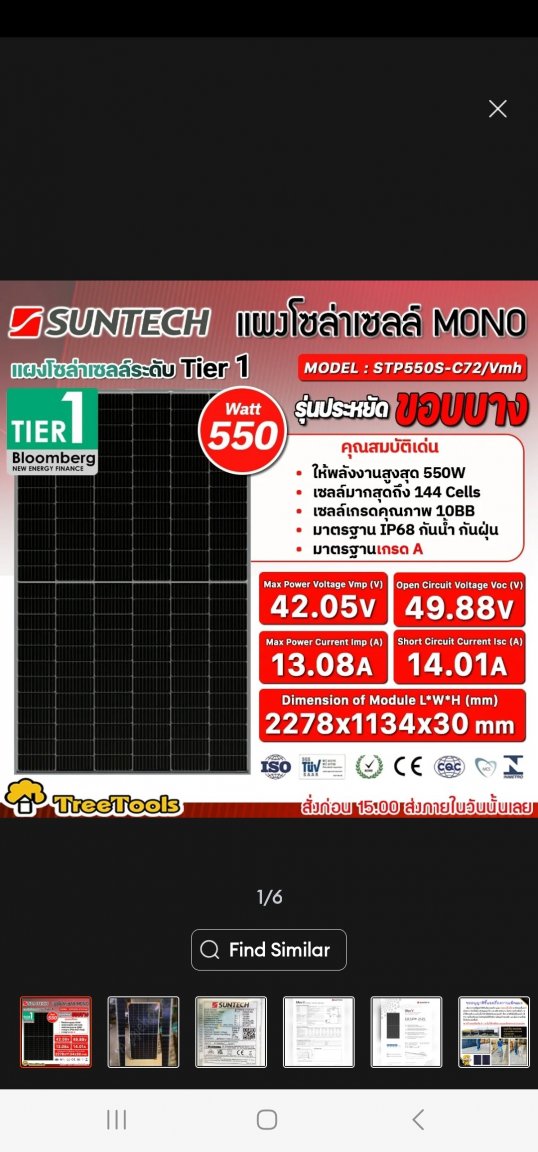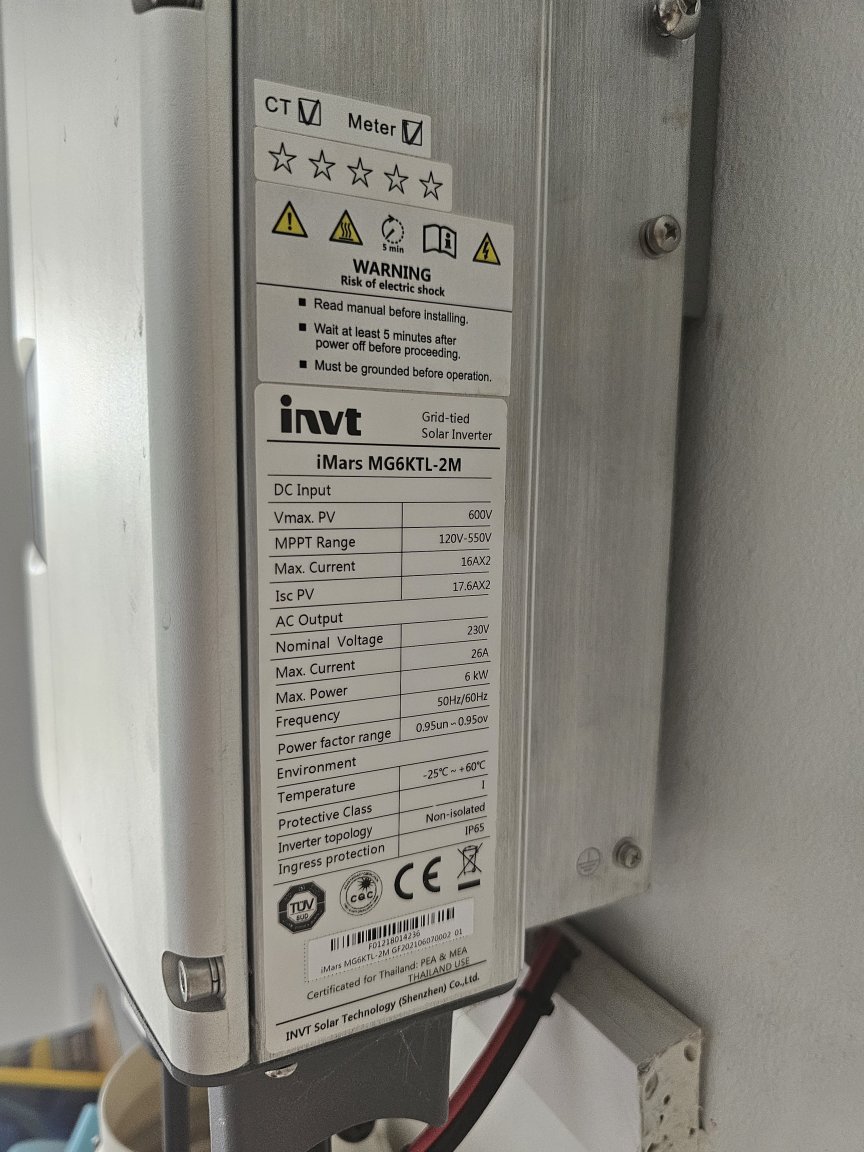
eddysacc
-
Posts
77 -
Joined
-
Last visited
Content Type
Events
Forums
Downloads
Quizzes
Gallery
Blogs
Posts posted by eddysacc
-
-
Anyone opened an interactive brokers account from thailand?
Tried to open in my wifes name years ago. But was not successful for i don't know the reason.
-
No. But i can recommend some from lazada. It was hit and miss bit now i found a good quality and cheap new zealand whole milk powder.
I can share the product if interested.
-
Can buy a deye 5kw for +- 30k thb.
I need 10kw or more.
This would be 2x deye= 60k thb
-
I would like to upgrade my sytstem which is grid tied now. Running an 6kw Invt grid tied inverter.
Now we need at least 10kw in panels.
in the future when the 3 kids (or more 😅) get their own rooms with aircons it would be nice to have the option to add more panels.
My idea was to buy a 16kw single phase deye hybrid inverter.
But the 100k Thb are not really in the budget right now to be honest. Having children is always more expensive then thought i guess.
So recently i saw the PowMr hybrid inverters. They look good for the wallet.
There is a 10.2 KW hybrid for around 15k Thb in promotion.
https://s.lazada.co.th/s.r2qXX
Any experience anyone.
Would it make sense to buy a low end quality PowMr hybrid inverter? Or would that not be wise?
Any other options?
I would need to buy 10kw+ of life4po batteries. But thats anotehr topic.
-
You could look in juck russel thailand Facebook groups.
This is how we got our male puppy russel last year.
I do t have Facebook. Must ask wifey to tell me the group name.
-
 1
1
-
-
Does the importet battery come with warranty?
I see some batteries on lazada coming with a 5 year warranty.
I assume I would not be easy to enforce a warranty claim in thaialnd though.
May I ask you how long was the delivery time?
What currency did you pay,USD? Credit card or bank wire?
The battery looks very nicely priced.
But what if they scam me?
-
It is often said thst Lead Acid and AGM batteries exhibit a DoD range of 50% to 80%, emphasizing the need for cautious discharge levels. Lfp batteries, boasting a range of 90% to 95%, provide exceptional flexibility without compromising longevity.
I think to be on the super safe side and maxing out lfp battery life span it would be a good idea to not exceed the dod to excess and use only 85 to 90 % of its capacity.
That's what I do with my EVs lfp battery by the way. It seems to be working from the battery health measurements.
-
 1
1
-
-
-
Looking up the prices at lazada.
It's about 15k thb for a 12V 150AH lead carbon battery of the type you presented.
On the other side the prices for Life4po LFP batteries are the better choice in terms of bang for the buck.
To my understanding the life time with 6000 cycles is considerably higher with LFP.
So it's a no brainer to buy LFP battery at this point of time.
Correct me where I go wrong.
I think there are at least 3 to 4 decades ahead in my life to benefit of the >6000 cycles of a LFP battery.
Sodium ion batteries with their even more cycles could last even longer.
But who knows how long we may benefit of the globalised world supply chains. There are strong forces to bring the established system to a halt. That's for sure.
-
On 8/2/2024 at 3:32 PM, lom said:
How do you know what improvements they have made to the new line except for the upgraded display?
What features do you expect to get in a new generation of inverters, what are you missing in the current ones?
All the most charging features for my ev.
To name is direct communication inveter <-> car battery
This would also.allow Vehicle to grid
More efficient charging from.solar. preferably DC to DC
Some features are available in the US market what I see. But very pricey indeed.
-
5 hours ago, Muhendis said:
Perhaps I should mention, when looking at lead carbon battery specs., watch out for the maximum life expectancy. This will be either 15 or 20 years.
The difference between the two is the mode of operation. The VRLA type will be 15 years and the 20 year battery will be gel.
The life expectancy is based on standby use with trickle charge.
In all other respects except one, they perform as well as LiFePO4's.
The exception is: They are heavy.
You wouldn't want one of them in your smart phone.
I asked my friend Google indeed and all it showed was carbon lead batteries would have about 2000 cycles.
I will give it another try.
-
Am thinking about upgrading our home solar farm recently.
My idea is to buy a deye 10kw single phase hybrid inverter
+
About 20 kw of life4po battery capacity
But battery wise:
From my observation the battery prices for life4po LFP batteries have come down quite a bit over the last year or so.
But now there are new battery technologies on the horizon.
First the sodium lithium batteries which are going to be in mass production soon.
(There have been big projects been built in China recently)
I guess the solid state battery technology is not yet on the horizon for many years.
--> would it be wise to wait for the sodium batteries ? Opinions?
Inverter wise:
The deye sun hybrid Inverters are many years on the market if I have this right.
There was just a polished version of the deye sun announced last week. But all I see is that they put the old technology in a new box and upgraded the display.
Actually I am wondering when a new generation of hybrid inverters Will enter the market in thailand.
I have got a EV car to charge at home. So an improvement in charging technology would come as a bonus aswell.
Any new insights anybody?
-
 1
1
-
-
Any new insights anybody?
-
6 hours ago, Andrew Dwyer said:
Yes, i prefer to think of it this way, my Seal would have cost me a further 49.18% if bought in the U.K. and no doubt the cheapest electricity plan there couldn’t compete with my TOU meter ( 2.6 baht per unit ) here.How did you get a TOU Tarif of 2.6 baht
Mine is 3.5 baht + ft
-
Sorry for the late reply. There were busy days with the 3 kids.
Today there was a sunny day after all. Perfect for observing if the changes of the inverter settings made a difference.
And what can I say?
The inverter is still restarting when hitting 5.8kw output.
A) it might not be the export Setting in my case
B) IT MIGHT not be the possibly overheating of the inverter as I upgraded a stronger fan for cooling.
So it must be too many panels output for the 6kw rated on grid inverter.
Thank you for All the advice and Support. I really appreciate your Knowledge And ideas.
-
1 minute ago, JBChiangRai said:
I would buy a plug in voltmeter on Lazada and plug it in a socket and see how high it gets before it resets. Crossy will probably know what the permitted voltage is, probably 253v or something like that, if it's hitting that then shutting off you will know it is a weak grid.
Alternatively, try turning on a few heavy loads (air cons on cold etc) and see if it still happens, if it doesn't the problem is a weak grid. You could try removing a few panels until it doesn't happen (or enjoy the cool air).
I have 2 grid-tied inverters and 2 of mine will do the same, I've cadenced the voltages so they go off in succession until they are happy.
The export to grid is turned on but limited to 2500 Watt.
So there is always some demand.
Should I put that figure up?
-
On 8/31/2023 at 3:29 PM, Fruit Trader said:
What does the fault history show?
It shows no fault.
I just resetted the inverter the day before. It might be deleted.
Let's wait for a sunny day and check again.
-
On 8/31/2023 at 3:21 PM, JBChiangRai said:
Most grid-tied inverters will ramp up their output until they either reach the rated capacity and stay nailed close to that
or
Ramp up their output voltage until they hit the maximum voltage allowed and then error and restart.
I suspect yours is the latter. This happens on a weak grid connection because there is insufficient local demand on your side of the transformer.
Just adding some background info here:
I guess the Solar panels are already oversized for the inverter.
?
It's string 1 8x450w = 3600w
String 2 6x550 = 3300 w
I used to use only string 1 for quite some time and I don't remember having had these issues.
Now with string 2 working that's when the issues started to occur.
The inverter now also gets very hot.
I added acrive cooling but arrow d midday tye inveter would hit 60° CELSIUS on a sunny day for sure.
That's for your helpful comments JB:
The inverter indeed never goes over its rated AC output. that's true.
That might be it. Although there are some restarts when 6000w ac output is not hit.
The thing avoit the voltage is what I still don't know how to figure out.
Above I posted some screenshot of the 550w panels including some max voltage numbers.
How to calculate it?
Could high voltage surges cause some trouble here?
-
We have got an INVT ongrid inverter (invt mg 6ktl-2m) and sincevwe upgraded more panels it restarts frequently when the inverter is maxing out about midday.
It also gets very hot although we added a bit fan for active cooling.
Is there is too much output from all the panels for the inveter now?
Have a look - advice very much appreciated.
The setup as follows:
String 1: 8x 450w.mono panels
String 2: 6x 550w mono panels
-
How is it going on?
-
- Popular Post
- Popular Post
On 5/13/2023 at 10:38 AM, Coota said:Is the car still for sale?
Sold already
-
 2
2
-
 1
1
-
How much is the cost to get a already installed solar farm registered with PEA/MEA
(Let's assume 5kw 1 phase)
Any "guesstimates"?
-
On 4/16/2023 at 6:40 PM, UWEB said:
I just have started the PEA Registration Process for my new System, my Installer is doing all. Costs are 20.000 THB and will take around 3-4 month time.
Would you tell more about it?
I think there are many members here who are keenly interested in hearing your Story!
-
Why not bying solar farm stocks?
There are some German solar-farmers stocks (that I own)
The operate solar farms in different countries and they have a profitable business model. Positive cash flow. Paying dividends for years.
Downside is, this business Modell is very capital intensive and has a long payback period. So rising interest rates will do no good over the long run.
But who knows what the big thinkers will do with us and our money supply next.




Looking for thai language school in khon kaen
in Language School Courses
Posted
Anybody?